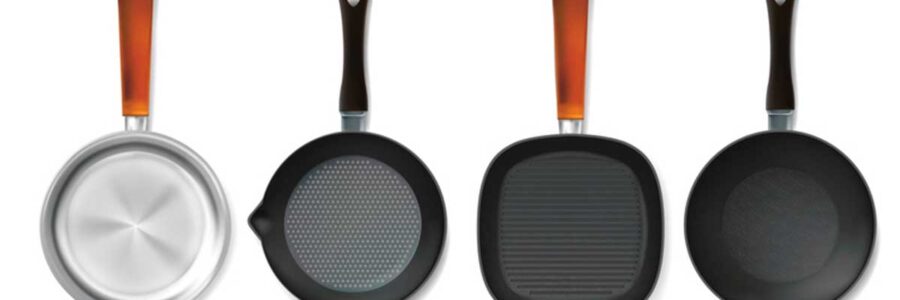Cookware plays a vital role in our culinary endeavors, but it’s essential to be aware of the potential health risks associated with certain cookware, specifically Toxic Cookware and Healthier Alternatives. Traditional toxic cookware often contains harmful chemicals or metals that can leach into our food, presenting health hazards over time.
Teflon (Non-Stick) Cookware
Teflon-coated or non-stick cookware, while convenient, can release toxic fumes when heated at high temperatures. These fumes contain perfluorooctanoic acid (PFOA), a chemical linked to various health issues. Overheating or scratching the non-stick coating can also cause it to flake off into food, potentially ingesting harmful substances. Prolonged exposure to PFOA has been associated with hormonal imbalances, reproductive problems, and even cancer.[1] It is advisable to limit the use of Teflon cookware and opt for healthier alternatives.
Aluminum Cookware
Uncoated aluminum cookware can lead to metal leaching, especially when used with acidic or alkaline foods. Aluminum is a reactive metal; when it comes into contact with certain ingredients, small amounts can seep into the food. High levels of aluminum in the body have been associated with neurological disorders, such as Alzheimer’s disease.[2] Be cautious with older or damaged aluminum pots and pans, as most aluminum cookware now comes with non-reactive coatings.
Copper Cookware
Unlined copper cookware can also leach into food when heated. Copper is a heavy metal that can accumulate in the body and lead to health complications over time.[3] High-quality copper cookware often features stainless steel or tin lining, creating a barrier between the food and the copper.
Non-Food-Safe Ceramic and Enamel Cookware
Certain ceramic and enamel cookware may contain lead or cadmium in their glazes. These heavy metals can contaminate food when the glaze becomes worn or damaged. Lead is a toxic substance that can harm the nervous system, affect cognitive development in children, and lead to health issues. To mitigate these risks, opt for certified food-safe ceramic or enamel cookware or choose non-toxic alternatives.
Non-Toxic Cookware Alternatives
Ceramic Cookware
Ceramic cookware is a top choice for health-conscious individuals. Made from clay and minerals, it’s free from harmful chemicals such as PFOA and PTFE, commonly found in non-stick coatings. Ceramic cookware is known for its excellent heat retention, even cooking, and the ability to withstand high temperatures.
Stainless Steel Cookware
Stainless steel cookware has long been a staple in kitchens worldwide due to its durability and versatility. It is composed of an alloy of various metals, including chromium and nickel. The best stainless steel cookware features high-quality construction with a core of aluminum or copper, ensuring even heat distribution. This non-toxic option is resistant to corrosion and does not release harmful substances into your food. Stainless steel is non-reactive, meaning it won’t interact with acidic or alkaline foods, preserving the flavors and integrity of your dishes. Additionally, stainless steel cookware is easy to clean and maintain, making it a convenient choice for everyday cooking.
Cast Iron Cookware
Cast iron cookware has withstood the test of time and is a preferred choice for many cooking enthusiasts. These sturdy pots and pans are seasoned to create a natural non-stick surface, eliminating the need for synthetic coatings. Cast iron offers excellent heat retention and distribution, ideal for searing, braising, and slow cooking. While it may require extra care to maintain its seasoning, cast iron cookware is an excellent non-toxic option that adds depth and flavor to your meals.
Glass Cookware
Glass cookware is prized for its non-reactive nature and ability to preserve the flavors of the ingredients. Made from tempered borosilicate glass, this cookware is resistant to thermal shock and can be safely used in the oven, microwave, and freezer. Glass is entirely free from chemicals and coatings that could leach into your food, ensuring a pristine and healthy cooking experience. It also offers easy cleaning and the ability to monitor the cooking process without lifting the lid.
Carbon Steel Cookware
Carbon steel cookware, often used in professional kitchens, is gaining popularity among home cooks. This lightweight and durable option heats up quickly and distributes heat evenly, making it ideal for searing and stir-frying. Carbon steel requires seasoning to build a natural non-stick surface. This non-toxic cookware becomes increasingly non-stick with proper care over time.
Conclusion
Choosing non-toxic cookware is a significant step toward creating a healthier kitchen environment. Teflon (non-stick) cookware, uncoated aluminum and copper cookware, and non-food-safe ceramic and enamel cookware pose potential health risks due to the chemicals or metals they can leach into our food. However, ceramic, stainless steel, cast iron, glass, and carbon steel cookware offer excellent alternatives that prioritize health without compromising performance.
By embracing these non-toxic options, you can enjoy the art of cooking while ensuring that the food you prepare is free from harmful substances. Invest in cookware that promotes your culinary delights and overall well-being, allowing you to savor every dish with peace of mind and a happy heart.
References:
- Sajid M, Ilyas M. PTFE-coated non-stick cookware and toxicity concerns: a perspective. Environ Sci Pollut Res Int. 2017 Oct;24(30):23436-23440. doi: 10.1007/s11356-017-0095-y. Epub 2017 Sep 14.
- Kandimalla R, Vallamkondu J, Corgiat EB, Gill KD. Understanding Aspects of Aluminum Exposure in Alzheimer’s Disease Development. Brain Pathol. 2016 Mar;26(2):139-54. doi: 10.1111/bpa.12333. Epub 2015 Dec 8.
- Jaishankar M, Tseten T, Anbalagan N, Mathew BB, Beeregowda KN. Toxicity, mechanism and health effects of some heavy metals. Interdiscip Toxicol. 2014 Jun;7(2):60-72. doi: 10.2478/intox-2014-0009. Epub 2014 Nov 15.
- Michael Fralick, MD, Aaron Thomspson, MD MPH, and Ophyr Mourad, MD MSc. Lead toxicity from glazed ceramic cookware. CMAJ. 2016 Dec 6. doi: 10.1503/cmaj.160182.


